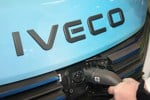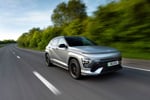If your business needs a small van, there has never been a bigger choice available. With seven manufacturers – or eight if you count MG and Rover as separate concerns – all vying for your business, there should be something here for everyone and for every budget.
There are still some pretty basic vehicles on the market, all plastic seats and acres of grey plastic interior.
There are also some pretty high specification vans that really are cars with no back seats.
These top level models may be aimed at the owner driver, or at small business, but there are some pretty big fleets using car-derived vans too. BT and the Post Office come to mind straight away. Like many sectors of the commercial vehicle market, service intervals have been growing, reducing running costs across the board. Some of these vans offer up to two years between trips to the garage. For some owners covering low annual mileages that means just one service in a three-year lease period.
All prices are standard list prices that were correct at the time of going to press. Fleet buyers will know how flexible, or not, those prices may be with a little arm-twisting.
Citroen C15 Champ
Ah yes, the Citroen C15 – apparently one of Noah’s joiners turned up in one. It may be older than the hills on which it’s driving, but the faithful Champ keeps rolling off the production line. Why? Because we keep buying them.
And with a special cashback offer currently knocking the base model down to just £4,995 plus VAT and delivery, it’s hardly surprising. Base model? That’s right, there are two versions of the C15 available – the D600 and the D765. Those numbers relate to payload including the driver. Both models use the 60bhp version of Citroen’s 1.9-litre diesel engine, but only the D765 gets power steering as standard.
The Champ was designed in the days of sticking a big capacity cubed box on the back of a car chassis, but it’s none the worse for that. A load floor length of 1.65m leaves everything else in the price range standing and that high roof means an internal volume of 2.66cu m. A half height bulkhead is standard, along with ‘a powerful load compartment light’. Oh yes, no expense spared for the C15 driver.
Seriously, though, with a three year/100,000 mile warranty as part of the package, there are few cheaper ways to haul a load.
Fact file
Citroen C15 Champ D600
Power: 60bhp@4,600rpm
Torque: 77.5lb-ft@2,500rpm
Load volume: 2.66cu m
Gross vehicle weight: 1,545kg
Payload: 600kg
Price: £6,695 + VAT (cashback price £4,995 + VAT + del) Citroen C15 Champ D765
Power: 60bhp@4,600rpm
Torque: 77.5lb-ft@2,500rpm
Load volume: 2.66cu m
Gross vehicle weight: 1,710kg
Payload: 765kg
Price: £7,445 + VAT Fiat Punto Van The latest generation Punto Van isn’t exactly a common site on the roads in the UK yet, which is a shame as it certainly has distinctive looks. There’s the regular choice of petrol and diesel motors, the oil burner being a mighty fine common-rail Multijet 1.3-litre. This 16v engine kicks out 70bhp, backed up by an almost class-leading 133lb-ft of torque. And for once the diesel engine trounces the petrol variant on power and torque, as the 1.2-litre petrol motor can manage just 60bhp and 75lb-ft of torque. Punto drivers can see how they are using the engine too. A trip computer is part of the standard instrument cluster, offering real-time information including average fuel consumption and available range. Perhaps of more use are a driver’s airbag, height and lumbar adjustable driver’s seat and a half steel bulkhead with a mesh upper section. From July 2004 production, ABS brakes have also become part of the standard package (previously a £300 option). The Punto manages a full 1cu m of loadspace, with a payload of 510kg. That’s competitive with the Corsavan, but a bit behind the Fiesta and the Clio. Fact file Fiat Punto Van 1.2 8v petrol
Power: 60bhp@5,000rpm
Torque: 76lb-ft @2,500rpm
Load volume: 1cu m
Gross vehicle weight: 1,430kg
Payload: 510kg
Price: £7,595 + VAT Fiat Punto Van 1.3 Multijet diesel
Power: 70bhp@4,000rpm
Torque: 133lb-ft@1,750rpm
Load volume: 1cu m
Gross vehicle weight: 1,515kg
Payload: 510kg
Price: £8,264 + VAT Ford Fiesta Van If it’s a compact van you are looking for, you could do a lot worse than consider the baby Ford. For some years now small cars with the Blue Oval have been picking up awards for their handling and driving experience, and the vans are no exception to that. The old 1.8-litre diesel engine has gone, to be replaced by a new 1.4-litre Duratorq TDCi common rail motor, built in a joint deal with Peugeot Citroen. There’s a 1.3-litre Duratec petrol engine available too, but why bother? That peach of a diesel kicks out 68bhp versus 70bhp for the petrol, but the diesel has a solid 118lb-ft of torque, well above the 78lb-ft that the Duratec can manage. What’s more, you can carry more in the diesel powered van, with a payload of 497kg against 465kg. That’s more than the Corsa, but less than a Punto. Ford claims a class-leading load length though, at 1.32m, so if you need to carry longer loads then head for the Ford dealer, or buy a bigger van. Inside, the story is good too, with ABS brakes, driver and passenger airbags, high security locks, seat belt pre-tensioners and a radio/cassette all on the standard specification list. Fact file Fiesta Van 1.3 Duratec
Power: 70bhp@5,600rpm
Torque: 78lb-ft@2,800rpm
Load volume: 1.013cu m
Gross vehicle weight: 1,540kg
Payload: 540kg
Price: £8,000 + VAT Fiesta Van 1.4 Duratorq TDCi
Power: 68bhp@4,000rpm
Torque: 118lb-ft@2,000rpm
Load volume: 1.013cu m
Gross vehicle weight: 1,585kg
Payload: 572kg
Price: £8,350 + VAT Peugeot 206 van Peugeot, like fellow French manufacturer Renault, offers its smallest commercial in just one model, you go with the 1.4-litre turbo diesel or nothing. But, like the Clio, the 206 Van is a little corker. Did we say French? The 206 Van is of course built in the firm’s Ryton plant near Coventry, along with the 206 car, so if you want to support UK manufacturing look no further. It’s a stylish motor, with plenty of specification, including ABS brakes, central locking, electric windows, remote-control radio/CD, sports seats and a full height bulkhead. You need those grippy seats too, as the little Pug is a hoot to drive on twisty roads. But don’t think the 206 is all about looks and driving enjoyment. With a payload of 526kg and a 1.13cu m loadspace it’s among the top players in the sector for hauling capacity. Power comes from the same 1.4-litre common rail engine as fitted to the Ford Fiesta, the two companies co-operating on diesel engine development. It’s a cracker too, developing virtually the same power and more torque than the old 1.9-litre Peugeot engine that it replaced last year. Fact file Power: 68bhp@4,000rpm
Torque: 112.5lb-ft@2,000rpm
Load volume: 1.13cu m
Gross vehicle weight: 1,562kg
Payload: 526kg
Renault Clio Van
All of these vans are, not surprisingly, very car-like to drive and live with. But none more so than the Renault Clio Van, with its electric windows, power steering, remote central locking and radio/CD player. It gets driver and passenger airbags too, along with ABS, EBD and brake assist.
But what’s it like as a van you say? Well, the compact Clio gets a one third height bulkhead and a load volume of just 0.95cu m. Payload is 535kg including the driver, which is on a par with many in the market.
But you get the feeling that this is a commercial vehicle for those with an appearance to keep up. The Renault is without a doubt stylish and you can enhance those looks with a ‘sports kit’ that includes spoilers, side skirts and alloys. True, you can do the same with some other makes, but the Renault is the one that looks as if those additions should have been there from day one. Renault has been at the forefront of the common rail revolution, so it will come as no surprise that the 1.5- litre motor in the Clio has the technology, though power and torque are no better than the competition. It means that Renault can offer two year, 18,000-mile service intervals though.
Power: 65bhp@rpm
Torque: 118lb-ft@rpm
Load volume: 0.95cu m
Gross vehicle weight: 1,515kg
Payload: 535kg
Price: £8,510 + VAT Rover Commerce/MG Express What do you do with an ageing car range, falling sales and a factory that needs to be kept busy? Pull out the back seats, blank out the windows and create a van line-up. That was the approach MG Rover took a couple of years ago, creating the Rover Commerce and, for the rapid courier on the move, the MG Express. Based on the old 200 series car, or ZR in MG-speak, the new vans aren’t actually bad at all. There is a choice of petrol and diesel engines in both line-ups, with two petrols and a diesel in MG colours. The vans have just under 1cu m of loadspace and payloads range from 485-520kg, which is on a par with others in the market. Where MG Rover puts clear space between itself and the competition is under the bonnet, when they say express, they really mean it. The basic 16v 1.4-litre petrol engine kicks out 84bhp, while the 2.0-litre turbodiesel has 101bhp on tap. Move across to the MG range and you get 103bhp and 160bhp petrol engines, along with the 101bhp diesel. They’re not cheap though, the Rover models run from £7,000-£8,200, but the MG models go from £8,200 to £11,400, and that’s plus the VAT. Fact file Rover Commerce 1.4 petrol
Power: 84bhp@6,000rpm
Torque: 81lb-ft@4,500rpm
Load volume: 0.979cu m
Gross vehicle weight: 1,520kg
Payload: 520kg
Price: £7,072 + VAT Rover Commerce 2.0TD diesel
Power: 101bhp@4,200rpm
Torque: 178lb-ft@2,000rpm
Load volume: 0.979cu m
Gross vehicle weight: 1,600kg
Payload: 485kg
Price: £8,264 + VAT MG Express 105 1.4 petrol
Power: 103bhp@6,000rpm
Torque: 91lb-ft@4,500rpm
Load volume: 0.979cu m
Gross vehicle weight: 1,520kg
Payload: 505kg
Price: £8,264 + VAT MG Express 160 1.8 VVC petrol
Power: 160bhp@6,900rpm
Torque: 129lb-ft@4,700rpm
Load volume: 0.979cu m
Gross vehicle weight: 1,550kg
Payload: 480kg
Price: £11,468 + VAT Express TD 2.0 diesel
Power: 101bhp@4,200rpm
Torque: 178lb-ft@2,000rpm
Load volume: 0.979cu m
Gross vehicle weight: 1,600kg
Payload: 475kg
Price: £8,774 + VAT Vauxhall Corsavan Vauxhall’s junior commercial has gone smooth and sporty this year, with body-coloured bumpers and more stylish headlights. Like many in the class, the Corsavan features new engines this year, with a 1.3-litre CDTi 16v common rail turbo diesel heading the range. This Ecotec-IV engine kicks out 70bhp, backed up by 126lb-ft of torque – that’s more than Ford’s Fiesta. The best feature for many about the diesel motor though will be that it only needs a service every 30,000 miles or two years. You can have a petrol if you must, the 1.2-litre engine pushing out 75bhp and 81lb-ft. Oddly, the petrol needs service attention first, at 20,000- mile intervals. The petrol motor also forms the basis for a 1.2-litre petrol/LPG dualfuel option. If you want to run on gas then you’re looking at a 3% drop in acceleration due to a slight drop in power. It beats the London congestion charge though. That cute rounded shape does impact on load volume slightly, but the Corsavan still manages 1.06cu m in the back and the payload is 465kg on petrol and diesel versions, dropping to 405kg with the dualfuel van. Fact file Vauxhall Corsavan 1.3CDTi Power: 70bhp@4.000rpm
Torque: 125lb-ft@1,750-2,500rpm
Load volume: 1.06cu m
Gross vehicle weight: 1,520kg
Payload: 465kg
Price: £9,289 + VAT Vauxhall Corsavan 1.2i 16v
Power: 75bhp@5,600rpm
Torque: 81lb-ft@4,000rpm
Load volume: 1.06cu m
Gross vehicle weight: 1,430kg
Payload: 465kg
Price: £8,869 + VAT
Power: 60bhp@4,600rpm
Torque: 77.5lb-ft@2,500rpm
Load volume: 2.66cu m
Gross vehicle weight: 1,545kg
Payload: 600kg
Price: £6,695 + VAT (cashback price £4,995 + VAT + del) Citroen C15 Champ D765
Power: 60bhp@4,600rpm
Torque: 77.5lb-ft@2,500rpm
Load volume: 2.66cu m
Gross vehicle weight: 1,710kg
Payload: 765kg
Price: £7,445 + VAT Fiat Punto Van The latest generation Punto Van isn’t exactly a common site on the roads in the UK yet, which is a shame as it certainly has distinctive looks. There’s the regular choice of petrol and diesel motors, the oil burner being a mighty fine common-rail Multijet 1.3-litre. This 16v engine kicks out 70bhp, backed up by an almost class-leading 133lb-ft of torque. And for once the diesel engine trounces the petrol variant on power and torque, as the 1.2-litre petrol motor can manage just 60bhp and 75lb-ft of torque. Punto drivers can see how they are using the engine too. A trip computer is part of the standard instrument cluster, offering real-time information including average fuel consumption and available range. Perhaps of more use are a driver’s airbag, height and lumbar adjustable driver’s seat and a half steel bulkhead with a mesh upper section. From July 2004 production, ABS brakes have also become part of the standard package (previously a £300 option). The Punto manages a full 1cu m of loadspace, with a payload of 510kg. That’s competitive with the Corsavan, but a bit behind the Fiesta and the Clio. Fact file Fiat Punto Van 1.2 8v petrol
Power: 60bhp@5,000rpm
Torque: 76lb-ft @2,500rpm
Load volume: 1cu m
Gross vehicle weight: 1,430kg
Payload: 510kg
Price: £7,595 + VAT Fiat Punto Van 1.3 Multijet diesel
Power: 70bhp@4,000rpm
Torque: 133lb-ft@1,750rpm
Load volume: 1cu m
Gross vehicle weight: 1,515kg
Payload: 510kg
Price: £8,264 + VAT Ford Fiesta Van If it’s a compact van you are looking for, you could do a lot worse than consider the baby Ford. For some years now small cars with the Blue Oval have been picking up awards for their handling and driving experience, and the vans are no exception to that. The old 1.8-litre diesel engine has gone, to be replaced by a new 1.4-litre Duratorq TDCi common rail motor, built in a joint deal with Peugeot Citroen. There’s a 1.3-litre Duratec petrol engine available too, but why bother? That peach of a diesel kicks out 68bhp versus 70bhp for the petrol, but the diesel has a solid 118lb-ft of torque, well above the 78lb-ft that the Duratec can manage. What’s more, you can carry more in the diesel powered van, with a payload of 497kg against 465kg. That’s more than the Corsa, but less than a Punto. Ford claims a class-leading load length though, at 1.32m, so if you need to carry longer loads then head for the Ford dealer, or buy a bigger van. Inside, the story is good too, with ABS brakes, driver and passenger airbags, high security locks, seat belt pre-tensioners and a radio/cassette all on the standard specification list. Fact file Fiesta Van 1.3 Duratec
Power: 70bhp@5,600rpm
Torque: 78lb-ft@2,800rpm
Load volume: 1.013cu m
Gross vehicle weight: 1,540kg
Payload: 540kg
Price: £8,000 + VAT Fiesta Van 1.4 Duratorq TDCi
Power: 68bhp@4,000rpm
Torque: 118lb-ft@2,000rpm
Load volume: 1.013cu m
Gross vehicle weight: 1,585kg
Payload: 572kg
Price: £8,350 + VAT Peugeot 206 van Peugeot, like fellow French manufacturer Renault, offers its smallest commercial in just one model, you go with the 1.4-litre turbo diesel or nothing. But, like the Clio, the 206 Van is a little corker. Did we say French? The 206 Van is of course built in the firm’s Ryton plant near Coventry, along with the 206 car, so if you want to support UK manufacturing look no further. It’s a stylish motor, with plenty of specification, including ABS brakes, central locking, electric windows, remote-control radio/CD, sports seats and a full height bulkhead. You need those grippy seats too, as the little Pug is a hoot to drive on twisty roads. But don’t think the 206 is all about looks and driving enjoyment. With a payload of 526kg and a 1.13cu m loadspace it’s among the top players in the sector for hauling capacity. Power comes from the same 1.4-litre common rail engine as fitted to the Ford Fiesta, the two companies co-operating on diesel engine development. It’s a cracker too, developing virtually the same power and more torque than the old 1.9-litre Peugeot engine that it replaced last year. Fact file Power: 68bhp@4,000rpm
Torque: 112.5lb-ft@2,000rpm
Load volume: 1.13cu m
Gross vehicle weight: 1,562kg
Payload: 526kg
Fact file
Renault Clio Van SL15dCi 65Power: 65bhp@rpm
Torque: 118lb-ft@rpm
Load volume: 0.95cu m
Gross vehicle weight: 1,515kg
Payload: 535kg
Price: £8,510 + VAT Rover Commerce/MG Express What do you do with an ageing car range, falling sales and a factory that needs to be kept busy? Pull out the back seats, blank out the windows and create a van line-up. That was the approach MG Rover took a couple of years ago, creating the Rover Commerce and, for the rapid courier on the move, the MG Express. Based on the old 200 series car, or ZR in MG-speak, the new vans aren’t actually bad at all. There is a choice of petrol and diesel engines in both line-ups, with two petrols and a diesel in MG colours. The vans have just under 1cu m of loadspace and payloads range from 485-520kg, which is on a par with others in the market. Where MG Rover puts clear space between itself and the competition is under the bonnet, when they say express, they really mean it. The basic 16v 1.4-litre petrol engine kicks out 84bhp, while the 2.0-litre turbodiesel has 101bhp on tap. Move across to the MG range and you get 103bhp and 160bhp petrol engines, along with the 101bhp diesel. They’re not cheap though, the Rover models run from £7,000-£8,200, but the MG models go from £8,200 to £11,400, and that’s plus the VAT. Fact file Rover Commerce 1.4 petrol
Power: 84bhp@6,000rpm
Torque: 81lb-ft@4,500rpm
Load volume: 0.979cu m
Gross vehicle weight: 1,520kg
Payload: 520kg
Price: £7,072 + VAT Rover Commerce 2.0TD diesel
Power: 101bhp@4,200rpm
Torque: 178lb-ft@2,000rpm
Load volume: 0.979cu m
Gross vehicle weight: 1,600kg
Payload: 485kg
Price: £8,264 + VAT MG Express 105 1.4 petrol
Power: 103bhp@6,000rpm
Torque: 91lb-ft@4,500rpm
Load volume: 0.979cu m
Gross vehicle weight: 1,520kg
Payload: 505kg
Price: £8,264 + VAT MG Express 160 1.8 VVC petrol
Power: 160bhp@6,900rpm
Torque: 129lb-ft@4,700rpm
Load volume: 0.979cu m
Gross vehicle weight: 1,550kg
Payload: 480kg
Price: £11,468 + VAT Express TD 2.0 diesel
Power: 101bhp@4,200rpm
Torque: 178lb-ft@2,000rpm
Load volume: 0.979cu m
Gross vehicle weight: 1,600kg
Payload: 475kg
Price: £8,774 + VAT Vauxhall Corsavan Vauxhall’s junior commercial has gone smooth and sporty this year, with body-coloured bumpers and more stylish headlights. Like many in the class, the Corsavan features new engines this year, with a 1.3-litre CDTi 16v common rail turbo diesel heading the range. This Ecotec-IV engine kicks out 70bhp, backed up by 126lb-ft of torque – that’s more than Ford’s Fiesta. The best feature for many about the diesel motor though will be that it only needs a service every 30,000 miles or two years. You can have a petrol if you must, the 1.2-litre engine pushing out 75bhp and 81lb-ft. Oddly, the petrol needs service attention first, at 20,000- mile intervals. The petrol motor also forms the basis for a 1.2-litre petrol/LPG dualfuel option. If you want to run on gas then you’re looking at a 3% drop in acceleration due to a slight drop in power. It beats the London congestion charge though. That cute rounded shape does impact on load volume slightly, but the Corsavan still manages 1.06cu m in the back and the payload is 465kg on petrol and diesel versions, dropping to 405kg with the dualfuel van. Fact file Vauxhall Corsavan 1.3CDTi Power: 70bhp@4.000rpm
Torque: 125lb-ft@1,750-2,500rpm
Load volume: 1.06cu m
Gross vehicle weight: 1,520kg
Payload: 465kg
Price: £9,289 + VAT Vauxhall Corsavan 1.2i 16v
Power: 75bhp@5,600rpm
Torque: 81lb-ft@4,000rpm
Load volume: 1.06cu m
Gross vehicle weight: 1,430kg
Payload: 465kg
Price: £8,869 + VAT













Login to comment
Comments
No comments have been made yet.